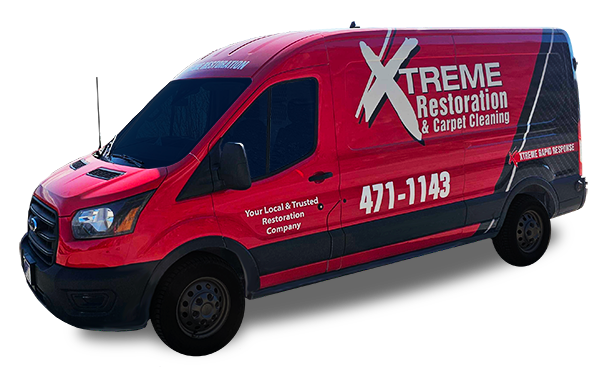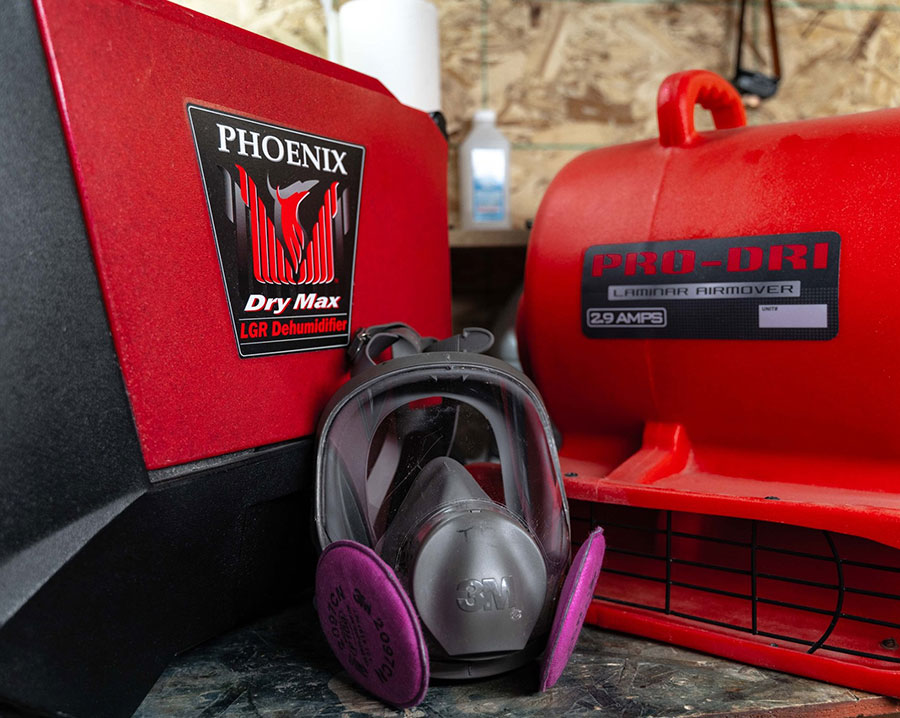It usually takes about 72 hours for everything to be dry after water damage. But, the time to dry walls after a flood can change with different things. The size of the house, the building materials, and how quickly you stop the water all matter a lot.
To dry out a room, it might take three days with good strategies. Air drying uses the natural wind to help, but it depends a lot on the weather. Using fans and dehumidifiers can make things dry much faster. Warm air helps too, but you must keep humidity low to prevent mold.
Being safe is very important when working on flood damage. Always check that electrical outlets are dry before using any tools. After the walls are dry, you must clean everything well to stop mold and kill bacteria.
Key Takeaways
- It usually takes around 72 hours to fully dry after a flood.
- How long it takes to dry depends on house size, materials, and the flood’s scope.
- Fans and dehumidifiers can make things dry much quicker.
- Being safe is really important; check electric outlets before drying walls.
- You need to clean thoroughly after drying to prevent mold and bacteria.
Understanding Water Damage
Water damage is a common global issue, often affecting houses and buildings. In Europe, more than half of all homeowners have experienced it. Knowing the main causes, types, and how to respond is key to fixing the problem.
What Causes Water Damage?
Water damage can come from nature or our own homes. Events like hurricanes cause big floods. Inside, leaking pipes and blocked gutters are often to blame. Faulty appliances, such as water heaters, can also lead to damage.
Categories of Water Damage
The level of water damage is put into three groups by experts. Recognizing these categories helps in dealing with the issue correctly.
- Category 1: This is clean water from sources like broken pipes or rain. It’s the simplest to clean.
- Category 2: Greywater has some impurities and needs decontamination. It’s more serious than Category 1.
- Category 3: Blackwater is the most dangerous, carrying sewage and bacteria. It needs complex cleaning.
Immediate Actions to Take
When you find water damage, it’s important to act fast. Here’s what to do:
- First, stop more water from coming in to avoid extra flooding.
- Figure out the damage category to know the hazards and safety steps needed.
- Start cleaning up quickly to lessen the damage. Use fans and dehumidifiers to dry the area faster.
- Make sure the space is well-aired. Use special techniques for drying, depending on the situation.
- Clean everything well after it dries to stop mold and bacteria from growing.
To make your home like it was before the damage, you must follow clear steps. Use the right tools and methods for the water damage type.
Initial Steps to Start Drying Walls
To begin drying water-damaged walls, it’s vital to assess the damage first. This means figuring out how much water has seeped into the walls. Experts use moisture meters to check water levels. If the readings show over 12%, the walls must be dried. Contractors use these meters to track how well the drying is going and to set a time for when the walls should be dry.
Assessing the Extent of Damage
Determining the water damage’s reach comes first. This is key in making a successful repair plan. Water can soak drywall up to 30 inches high, so a detailed look is needed. It’s also important to see if the water contains harmful substances. Knowing this helps keep everyone safe.
Using Moisture Detection Devices
Moisture meters are crucial for measuring how much water is in the walls. They give exact amounts. This information lets experts track the drying process. If the meter reads over 12%, the drywall is too wet. It must be dried to avoid mold.
Safety Precautions Before Starting
Staying safe is top priority before drying begins. This means checking for any electrical dangers. Sealing the room with plastic helps drying and keeps the area clean. Experts use special equipment and check on the drying daily. If water came from above, the ceiling might collapse. This is very risky and needs professionals right away.
Companies like Xtreme Carpet Cleaning & Restoration have the best tools for this job. They have moisture meters, special cameras, and powerful dehumidifiers. Using these, homeowners can get through the drying process quickly and safely.
Natural Drying Methods
When fighting water damage, natural drying ways work well. They use fresh air to dry things quickly. Opening doors and windows lets the air move, helping get rid of water.
This method counts on good weather. If it’s too humid or rainy, drying naturally might not work. So, check the weather before choosing this route.
Natural drying also means using your home’s heat to dry things. This is good, but you also need a dehumidifier. This catches the moist air, keeping your home a good place to dry.
Know that some water damage is easier to deal with. Clean water, like from broken pipes, is simpler to clean up. But dirty water, like sewage, needs special cleaning. You might have to use strong tools and clean very carefully.
Using natural ways and technology together is best. This makes sure you fix water damage fast and right. So, mix fresh air with high-tech help for the best results.
Technology for Speeding Up Drying
Investing in the right tech can make drying after a flood much quicker. New tools make water extraction a breeze.
Using High-Powered Fans
High-powered fans blast air quickly in wet areas to speed up drying. They’re key in getting surfaces dry fast. Axial fans are top picks for big areas because they push air further than usual fans.
The Role of Dehumidifiers
Dehumidifiers are vital in shrinking humidity. They’re great at pulling moisture from the air, drying walls and floors faster. Big dehumidifiers can pull out tons more water than common ones, which is key for fighting water damage and mold.
They also stop secondary damage by keeping humidity levels right. This is another step for keeping mold away.
Pressure Drying Techniques
Pressure drying can be both positive and negative. Positive pushes dry air in, booting moisture out fast. You need care with HEPA filters to avoid pollutants. It is normally used in empty spaces.
Negative drying sucks moisture away. It’s safer in places where people live but slower. Both ways make drying more efficient when used right.
Factors Influencing Drying Time
The time to dry walls after water damage varies a lot. This is because many factors affect drying times. Knowing these factors helps with a quick and efficient restoration to keep the project on schedule.
First, how bad the water damage is makes a big difference. There are three types of water damage by the IICRC: Category 1 is clean water, Category 2 is greywater, and Category 3 is blackwater. The more severe the category, the longer and more complex the drying process.
Second, the materials involved affect drying times too. Each type of material absorbs and releases moisture differently. For example, drywall dries quicker than wood. But, all materials need to be watched closely to avoid mold in the first 24 hours.
Also, the weather and where the damage is impact drying. How humid and hot it is matters. Higher humidity slows drying, but warmth speeds it up. It’s important to balance these with good airflow and dehumidification to avoid more problems.
Using new technology can also make drying faster. Positive pressure systems work better in breathable spaces. Dehumidifiers are key, especially the fast but costly adsorption type. They help control the humidity, making the drying more efficient.
Lastly, hiring professionals can make a huge difference in drying time. They have tools like infrared cameras and moisture meters. This lets them dry the area faster and more accurately than doing it yourself. More than half of all people owning property in Europe have dealt with water damage. This shows how important quick and professional help is.
To wrap up, how much water damage there is, what materials are wet, and the environment all affect drying times. This shows why fast and efficient actions are crucial when dealing with water damage.
How Long Does It Take for Walls to Dry Out After a Flood?
The time it takes for walls to dry after a flood can vary a lot. A few things come into play. It usually takes around 72 hours for walls to dry completely. Yet, bigger areas or buildings with a lot of water damage might need more time.
Impact of Material and Structure
The kind of material a building is made of affects how long it takes to dry. Different things like wood, drywall, and insulation soak up water in their own ways. This changes how long they take to dry. Tools like fans and dehumidifiers also have a big effect. Professional dehumidifiers can remove more water than home ones. This makes things dry faster.
Environmental Conditions
The environment also affects drying times. Things like how humid and hot it is can slow or quicken the drying process. Good airflow with dehumidifiers can remove moisture fast. Using fans and heaters together can make things dry quicker. It also helps prevent mold.
Severity of the Water Damage
How much water damage there is impacts drying time a lot. Clean water damage is easier to fix and dries faster. Water with pollution or bacteria takes longer to dry. This is because it must be cleaned first. For really bad damage, special drying techniques are needed. These ensure both safety and faster drying.
Drying out walls and ceilings can sometimes take weeks or months. This depends on how wet they got and the kind of material. Insulation often needs to be taken out and changed. This is because it can keep water for a long time. Checking the water damage well helps set a good drying plan.
Conclusion
Determining how long it takes to dry walls after a flood is quite complex. It depends on many things. Drying the walls right is key to stop mold or protect a building’s structure. Special dehumidifiers for big areas usually take 24 to 48 hours to work. It’s vital to pick the correct dehumidifier. You need to think about its size, how much it can hold, and its noise level. This ensures it does a good job especially in wet areas or in summer.
Using strong fans and big dehumidifiers can really speed up the drying. It’s smart to close off some spaces when dehumidifiers are running. This helps keep the place perfect for drying. Also, using tools like moisture meters and infrared cameras is a must. They help check and record all the wet areas. This info is crucial for insurance and to fix the damage right.
Even though letting things dry on their own or trying to do it yourself can help, big floods might need pros. Getting help from flood restoration experts ensures a fast and proper drying. This stops big issues like mold later. Using a mix of natural drying and high-tech methods that fit the situation is key to a good repair job.




















